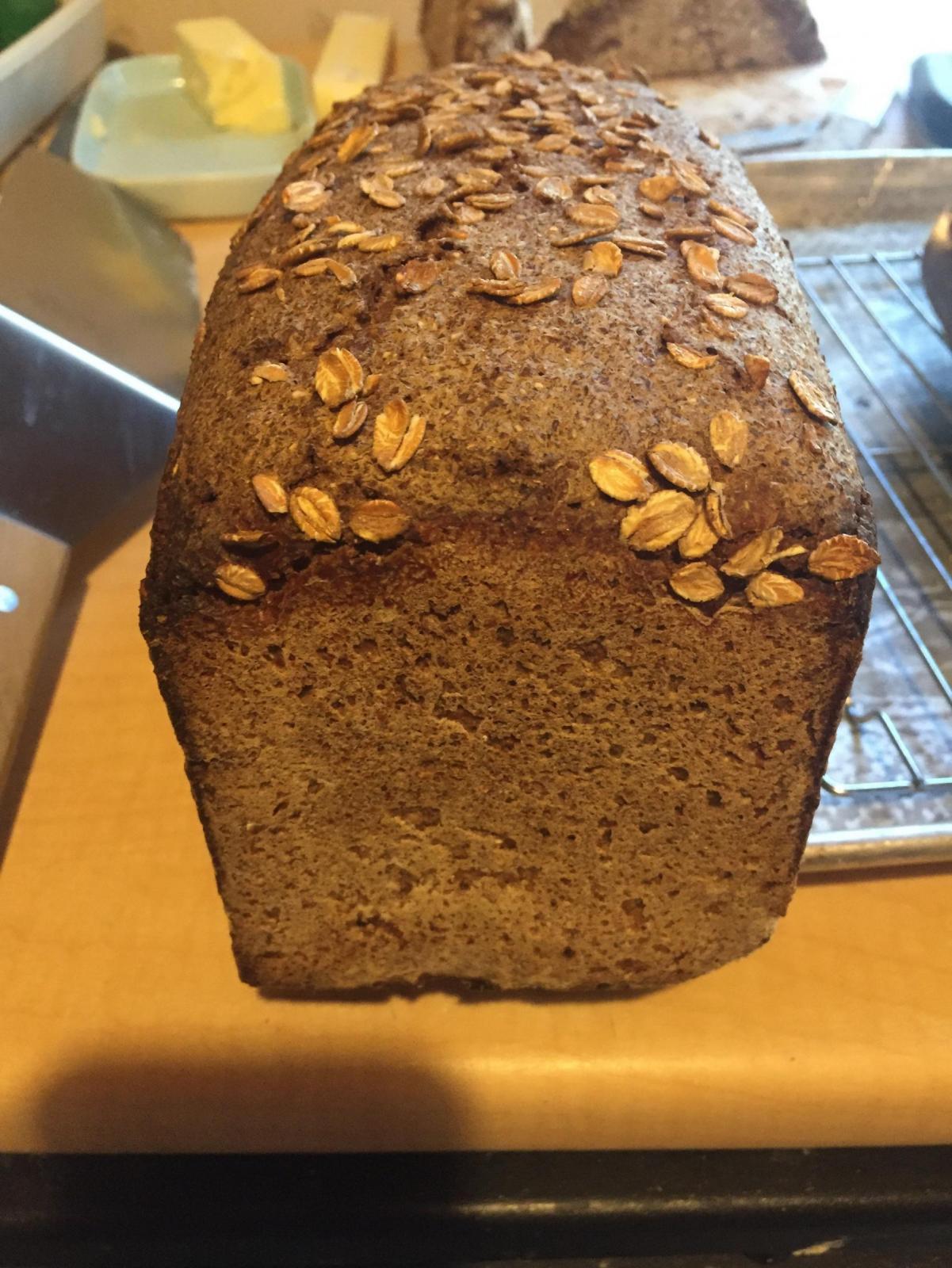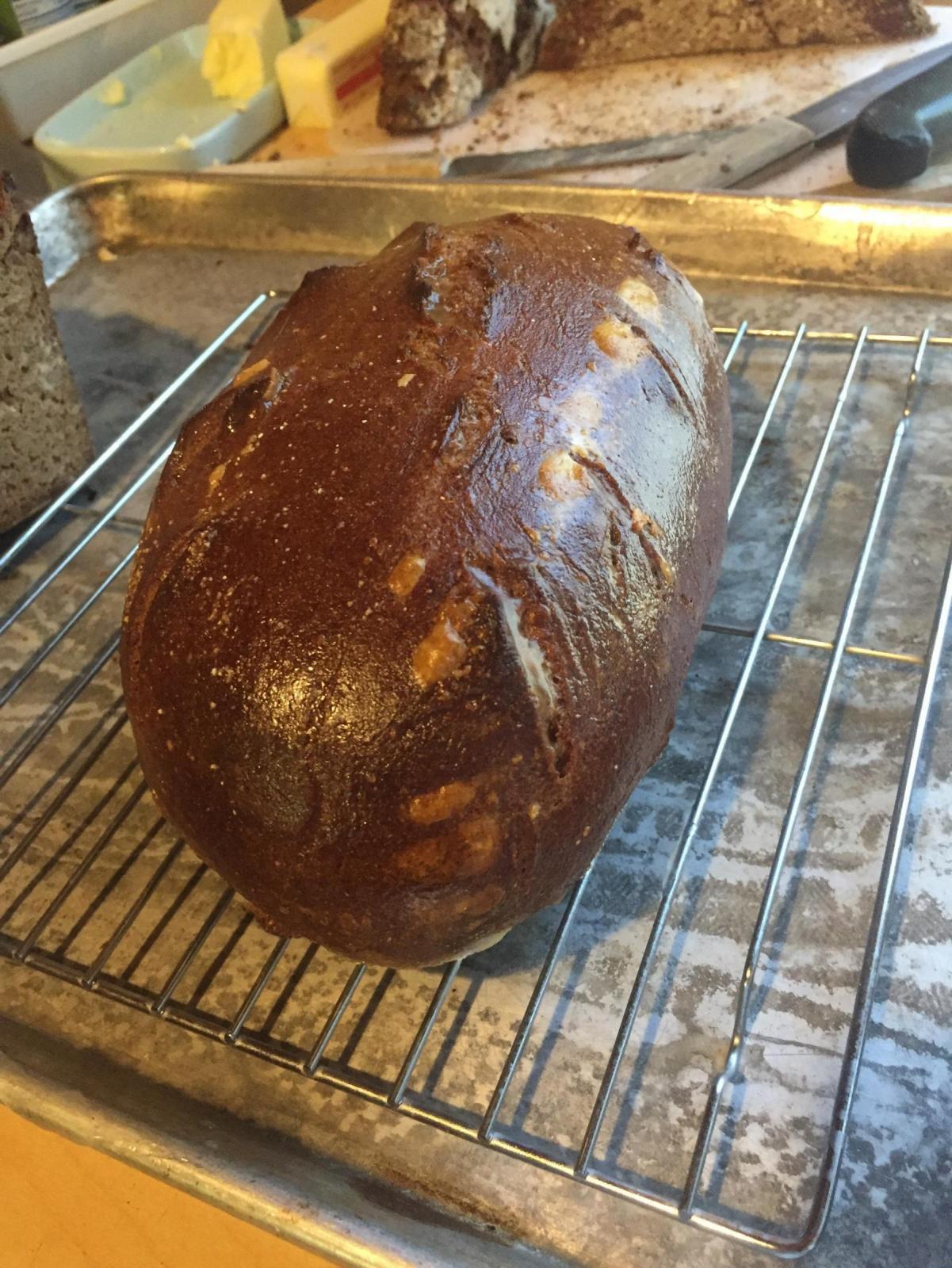After all, focusing on ryes. These are two ryes, both by Lutz Geissler. I would love to get proofing down perfectly, to obtain a surface with no cracks at all, but excellent spring. (I think that's the issue, right?). Handling and shaping rye is also still a bit weird for me, so working on that (the second bread is a bit misshapen).
The first is a Roggenvollkornbrot Lutz adapted from the master German baker Günther Weber:

The second is a Dreierbrot, from Lutz's first book (eventually, I'd like them all). You can see the surface fissures - would love to get this down, in part because I think it will help me improve Borodinsky, Riga, and similar breads. Also, the mounds of potato starch, which I lined the banneton with per Geissler.

Wow those look cool.
How about some crumb shots? :)
Rye really kicks my butt, so I have lots of respect for you and your results!
Well, thanks! I'm really a noob too when it comes to rye but I've come to love the grain and really digging staying in this world for awhile. I'm sticking pretty close to Lutz's times on things, adapting as best as I can for any environmental or equipment (our oven just can't get as hot as his starting temps) differences. I'll do the second bread crumb shot later (letting it rest at least till tonight....12 would be better, but can't wait that long, lol!), but for now, here's the vollkornbrot. It's delicious and my wife, Estonian family, loves it like crazy so that goes far with me.
It's really close crumbed as you can see, but in looking at Lutz's picture of the same, it's pretty close. So maybe that's to be expected with this kind of vollkornbrot? Don't know. But this is really rewarding.
PS: And I am re-committing to learning German. I can muddle through but I'm missing so much from his book and several other wonderful books on German baking. Fluent French, this is another beast. Wish me luck!
Looks similar to the Borodinsky crumb I've had. Not sure what is possible with all rye. Hope you're enjoying tasting it.
Those are both beautiful loaves of rye and I imagine that they taste every bit as good as they look.
Paul
Paul those two loaves are beautiful examples of rye breads. You must be so pleased with them. Any minor fissures do not take away from your success, well done. One of these days I’ll try to get back on the rye horse, but for now I’m working on 100% whole grain breads since I’m finally having some success with them.
Benny
These look great. I'm curious about the taste. Are they both whole grain rye breads? I recall you have a mill -- Are you milling the rye for these bakes? I'm curious how other home miller-bakers go about achieving the various granularities that seem to be called for in these classic rye bakes.
For the Vollkornbrot there's both wholemeal rye, which I mill here at home, and pumpernickel, which I got from Baker's Authority. Unfortunately I bought quite a bit and have been steadily working through it but plan to mill (as best as I can, with consistency) all the way from "gross schrot" (well, "coarse cracked," as I obviously can't do chops) through to my current milling fineness for whole rye flour. Right now I'm using the pumpernickel for both "fein" and "mittelschrot," and for coarse needs I have actual chops from Baker's Authority (Ardent Mills), as well as cracked rye from Janie's Mill.
The Dreierbrot calls for basically mediums/medium dark in all three grains - Roggen 1150, Dinkel 1050, Weizen 1050. I have "Medium Rye" from KA (which I think is probably closer to a German Type 1370 than 1150) and "Type 110" wheat from Central Milling (in range of the 1050), but I have to rely on my wholegrain spelt.
In terms of the rye, the mill is a tank and can do any of these grades, but because it's an infinitely variable tightness, I've been winging it. I should probably try to lay down a better measure than sight and feel in the fingers. I'd love to dial in a "feinschrot" between my flour and the pumpernickel.
I have bolted in the past to try to parse things like a T110, and it's fine, but because we're losing endosperm as well as husk, I don't find it's the same thing. Still, bolting is cool (thank you DanAyo), cheaper, and fresher so I'll do it after running through my current stocks of bought medium flours.
I have made Vollkornbrot a handful of times and the recipe calls for coarse rye, whole rye, and rye chops. I try to achieve these in the required portions using a combination of milling, sifting, and re-milling. I have a stack of 12 inch diameter sieves in 30, 40, 50, 60, and 70 holes per inch, and would like to get a better understanding of how to use these to approximate the various types of rye flours called for in many of these recipes. It ends up being quite a process, with bowls and sieves all over the place (not to mention the powder milling rye produces). That's probably the main thing preventing me from baking it more often, so I would like to learn more about it. I might order some flour samples of various kinds and try to "measure" them with sieves and then emulate with the mill.
Germans are super autistic about everything, but you have no cultural expectations of rye bread structure. Just don't mill it too fine and it's all good. Here's a sample of the whole rye flour I currently have:
I'd like it a bit coarser, but I got 20 kg of this for free. Someone posted pictures of Lithuanian whole rye flour in another thread. It's quite a bit coarser.
Some beautiful bakes there! The crumb on the vollkornbrot looks great...looking forward to the crumb shot on the second as well. I haven't ventured into any rye baking yet, mostly because I would be the only one eating them here in my house, but I can certainly appreciate the work and effort that goes into these bakes. I'm sure they are delicious.
I wish I had your "problems" handling and shaping rye dough. They look fantastic! Keep those ryes coming!
Wow, thanks you guys. I've learned tons from you and have a lot of respect for your work so this means a good deal to me. Thanks.
Jury is out for me on the Dreierbrot. My wife really likes it and I love the flavor, but the crust is a bit weird to me. Lol, I only realized after I'd painted the potato-starch glaze after baking, that I'd doubled what Lutz calls for in the formula because 20 g water and 1 g starch was too little work with. But I'd forgotten I'd doubled it, blithely lapped up every last bit and slathered it all on so, um, yep, that's shiny!
It's not a quality with which I'm familiar - never had this kind of a crust before - so I'm not sure what I'm tasting is representative. Not unpleasant, totally, but maybe something like eating the geo-rind of an Italian dry salami, or summer sausage, or something like that? Not for everyone?
Anyway, would love your counsel. Next time I'll try painting more lightly! This was sliced with a serrated knife so sorry for the butchery. Hope it gives an idea.
The crumb on this one looks a little fluffier than the other one. How's the texture?
This is going to sound weird, but it's the best way I think I can distinguish the two. Both are chewy; the vollkornbrot tends more towards cakiness but still chewy (the crumb still "tears," in the way a good French levain will tear; but it is more granular than levain), this towards rubber, obviously chewy. Something like the quality of certain egg-enriched breads, though more strength and resistance. Neither descriptor is bad - both are pleasant - but this the best way I can find to convey the qualities.
The thing I want to work on with the second one is the crust. I imagine when I quit being such a dork and doubling up on the glazing, it will be an improvement.
Very nice indeed! You may have your reservations about the crust but just you wait till you get to that crumb.
There's also a round loaf in the background.
LOL, oh, you saw it, damn...hahahha. Yeah, one very overproofed Geissler bread. Backyard critters are about to receive a bounty...😂
Thanks for posting these inspirational bakes!
Q: For those of us who'd like the fun of trying (and failing) but don't have access to Lutz Geissler's books, are these formulas available anywhere online?
Oh, and, good luck with your effort to learn German. Language is culture.
Rob
Thanks, Rob, you bet. Yep, Lutz has his website, with more recipes than I'll ever bake. If you have google translate it also does a good job of rendering everything in English (although some of the words can be truly hilarious). Has a recipe index, by types of all kinds:
https://www.ploetzblog.de/alle-rezepte/
Also check out "The Brotdoc":
https://brotdoc.com/rezepte-a-bis-z/
AND our own Karin Hanseata!:
http://brotandbreaddeutsch.blogspot.com/p/rezept.html
(Karin also has a great guide to emulating German flours here).